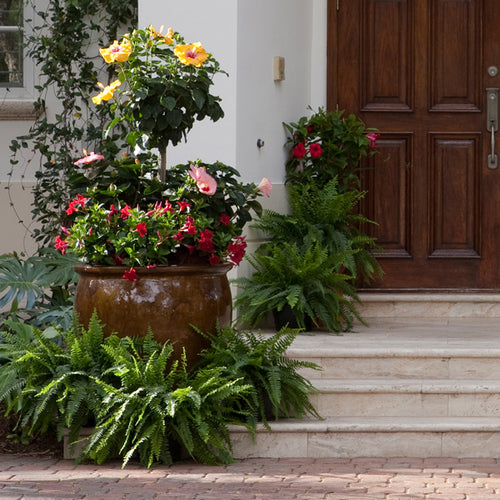
Lamb's Ears
As a general rule deer turn up their noses at fuzzy-leaf plants such as lamb’s ears, Stachys byzantina. Its handsome silver gray foliage looks terrific planted between pink-, blue-, or white-flowering perennials. The plant’s foliage grows about 6 to 10 inches tall, and in midsummer it sends up 2-to-3-foot-tall flower spikes laden with pink-purple flowers. Lamb’s ears needs full sun and is hardy from zones 4-9.
Hyssop
One of the easiest perennials to grow, hyssop thrives in hot, sunny locations and produces quantities of blue, pink, white, or yellow flowers, depending on variety. Heights also vary, but most grow about 2 to 4 feet tall. Deer avoid the plant’s fragrant foliage, but bees and butterflies flock to its nectar-rich blooms. Hyssop also has a long bloom time and will remain colorful from midsummer until fall. Hardy from zones 4-10
Ajuga
Low-growing ajuga is a delightful little groundcover for sun or shade (depending on your growing conditions). In addition to forming a weed-smothering mat of foliage, it's decked out in adorable lavender-purple flowers in early spring. Deer generally pass it by for more tasty plants. Hardy from zones 3-9
Columbine
Held aloft on airy stems, the blooms of columbine dance every time the wind blows. A North American native, columbine, Aquilegia canadensis, is a super easy, deer-resistant, spring bloomer that comes in a wide variety of colors and bicolors. The bell-shaped, spurred flowers, which appear in spring and early summer, are a hummingbird favorite too. As a rule, columbine is a short-lived perennial that fades away after a few years, but most varieties spread seeds that develop into new plants every spring. It prefers cool temperatures and a partially shady location. Hardy from zones 4-9
Artemisia
Plant it and forget it! That’s what you can do with artemisia. This handsome silver-leaf perennial is tough enough to handle cold winters and hot, dry summers with little attention. Artemisia comes in a variety of forms that all share the family’s tough nature and fragrant, silver-gray color. And best of all, even the hungriest deer will walk right by this hardy plant. Heights range from 8 inches to 4 feet tall, depending on variety. Some varieties spread quickly so plant artemisia along a walk or wall where it can be easily controlled. Hardy from zones 4-10
Hellebore
If deer have turned your shade garden into their personal all-you-can-eat buffet, consider planting hellebore. This cheerful shade dweller is deer resistant and is also one of the first plants to bloom in the spring (this is why it’s often called Christmas or Lenten rose) producing lovely rose-like flowers on 2-foot tall plants. In addition, hellebores are evergreen, sporting colorful leaves throughout the winter. Flower colors include white, cherry, pink, and bicolored. Hardy from zones 4-8
Yarrow
Some perennials just seem to have it all. Take yarrow, for example. This super hardy, sun-loving perennial has pretty fern-like foliage, jewel-like, nectar-rich flowers that attract bees and butterflies, and a rock-hard constitution that protects it from heat, cold, insect pests, and most importantly, deer. The plants are not fussy about soil type and bloom from June to September. Height varies by variety, but most grow 2 to 3 feet tall. Hardy from zones 3-9
Foxglove
The supermodel of the perennial border, foxglove is prized for its tall, slender stems of glamorous trumpet-shape flowers with purple spotting inside. Foxglove, Digitalis purpurea, is available in a variety of colors and can grow 1 to 6 feet tall. Technically, foxglove is a biennial which means it grows one year, blooms the second, and then dies back. But if you prune away the flower stalk when three fourths of the flowers have faded, you can often prolong the life of the plant another year. But don’t worry because foxglove self sows generously so even if the original plant dies you’ll still have a constant supply of new flowers. Foxglove is deer resistant and prefers a partially shady location with rich, moist soil. Hardy from zones 4-8
Bee Balm
One of the best ways to know if a plant is deer-resistant is to rub the foliage. Deer have a tendency to avoid plants with aromatic or pungent leaves. Bee balm, Monarda didyma, is a great example. The leaves, stems, and roots of this sun-worshipping member of the mint family have a distinct orange-like odor when rubbed or crushed that deer tend to avoid. Bee balm grows 2 to 4 feet tall and is smothered in crown like heads of nectar-rich flowers that will lure bees, butterflies, and hummingbirds to your garden during the summer. Flower colors include red, blue, violet, white, and pink. Like other plants in the mint family, bee balm can grow fast, so plant it where you can control its spread. Hardy from zones 4-9
















